October 2025
The global bio-based propylene glycol market volume accounted for 2,322,157.1 tons in 2024, grew to 2,530,686.8 Tons in 2025, and is expected to be worth around 5,487,311.8 Tons by 2034, poised to grow at a CAGR of 8.98% between 2025 and 2034. The growth of the market is driven by the growing demand from various industries due to increasing adoption of biobased and greener alternatives due as rising awareness about the environment fuels the growth.
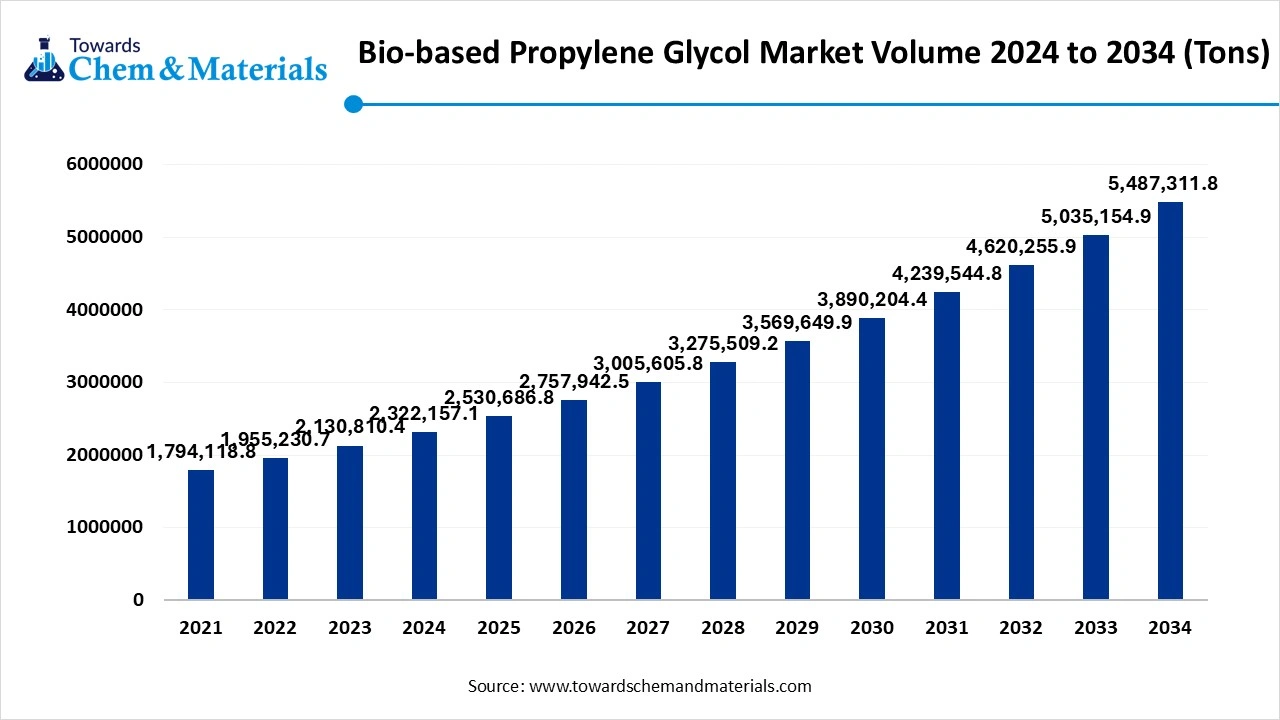
Rising demand for durable materials: Bio-based Propylene Glycol market to expand
Bio-based Propylene Glycol (Bio-PG) is a sustainable, renewable alternative to petroleum-based propylene glycol. It is primarily produced from plant-based feedstocks such as glycerin, sorbitol, glucose, and starch through hydrogenolysis or fermentation processes. Bio-PG serves as a versatile intermediate and solvent used in a wide array of applications, including personal care, pharmaceuticals, antifreeze, de-icing fluids, food additives, and unsaturated polyester resins (UPRs).
The bio-based propylene glycol market is mainly propelled by rising consumer interest in sustainable products, technological improvements in production methods, and government incentives promoting bio-based materials. Furthermore, increasing awareness of chemical safety and the push for eco-friendly options contribute significantly to market expansion. The growth is also supported by the expanding end-use sectors such as automotive, pharmaceuticals, food and beverages, and cosmetics and personal care, which further drive market demand.
| Report Attributes | Details |
| Market Volume in 2025 | 2,530,686.8 Tons |
| Market Volume by 2034 | 5,487,311.8 Tons |
| Growth rate from 2024 to 2025 | CAGR 8.98% |
| Base Year of Estimation | 2024 |
| Forecast Period | 2025 - 2034 |
| Dominant Region | North America |
| Segment Covered | By Source (Feedstock Type), By Application, By Grade, By Production Process, By End-use Industry, By Distribution Channel, By Region |
| Key Companies Profiled | Archer Daniels Midland Company (ADM), BASF SE, The Dow Chemical Company, Global Bio-Chem Technology Group Co., Ltd., LyondellBasell Industries N.V. , DuPont Tate & Lyle Bio Products Company, LLC , Oleon NV (part of Avril Group) , Cargill, Incorporated , Manali Petrochemicals Ltd., Repsol S.A., Tokyo Chemical Industry Co., Ltd., Ashland Inc., Shell Chemicals, Huntsman Corporation, SK picglobal, INEOS Oxide , Shenzhen Simeiquan Biotechnology Co., Ltd., Mitsubishi Chemical Group, AGC Chemicals, Solvay S.A. |
What Are the Key Growth Opportunities Responsible for The Growth of The Bio-Based Propylene Glycol Market?
The key growth opportunity responsible for the growth of the market is the growing demand for sustainable products, increasing preference for bio-based and renewable materials from various industries fuels the growth of the market. Consumers are actively seeking products with a lower environmental impact, and the adoption of sustainable ingredients and materials by the industries also fuels and boosts the growth of the market.
The key challenge is the limited feedstock availability and price fluctuations. This is due to fluctuating agricultural conditions and competition from other industries, which impact the stability and biobased propylene production, causing price fluctuation, which is a challenge in the growth of the market. The high production costs due to the use of advanced and complex technologies require high investments for setup, which is a challenge hindering the growth of the market.
How Did North America Dominate the Bio-Based Propylene Glycol Market In 2024?
The North America bio-based propylene glycol Market Volume was estimated at 836,525.3 tons in 2024 and is anticipated to reach 1,897,573.9 tons by 2034, growing at a CAGR of 8.53% from 2025 to 2034. market with a market volume share of 36.02% in 2024
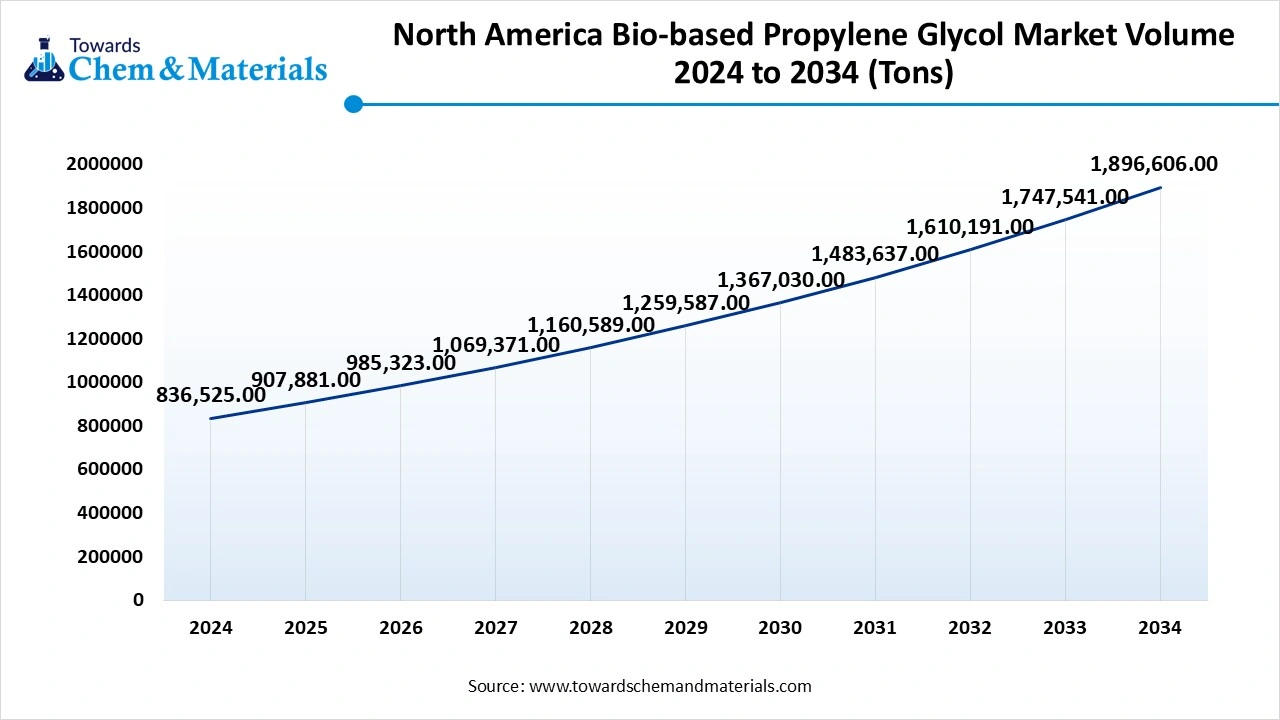
North America dominated the bio-based propylene glycol market in 2024. The growth of the market is driven by the growing awareness of environmental impact and demand for the use of biobased products fuels the growth of the market in the region. Key players of the region also contribute to the growth like The Dow Chemical Company, BASF SE, Archer Daniels Midland Company (ADM), Cargill, and LyondellBasell Industries N.V. The growing demand for sustainable products across industries, supportive regulation in the region, and well-established infrastructure for the development of bio-based products boost the growth of the market in the region.
The U.S. Has Seen a Rapid Growth Due To the Presence of a Mature Market.
The growth of the market is driven by the growing and key application of biobased products and expanding industries in the fields like cosmetics and personal care, pharmaceutical, food and beverages, automotive, and construction. These companies demand biobased products due to increased adoption resulting from increased environmental awareness amid rising environmental concerns associated with the use of hazardous and chemical products, which boosts the growth of the market in the country.
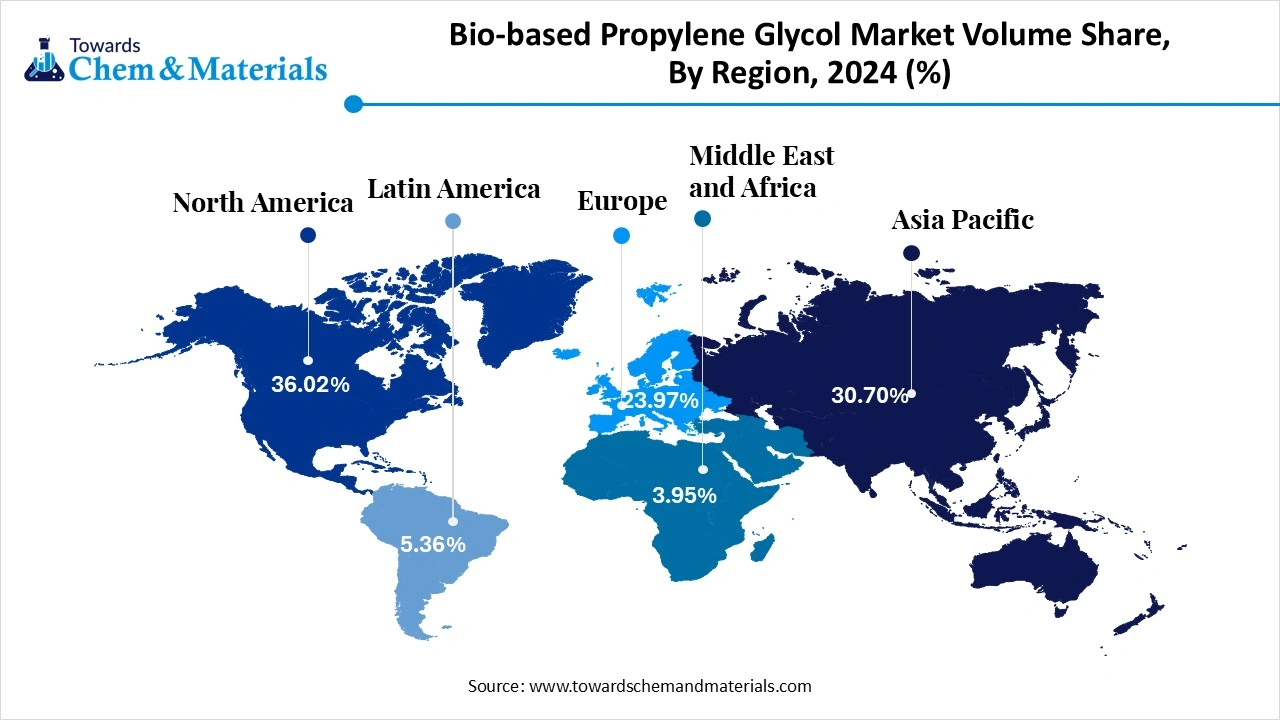
Asia Pacific Is Seeing Growth in The Market Driven by The Growing Awareness.
Asia Pacific is expected to experience significant growth in the bio-based propylene glycol market in the forecast period. The growth of the market is driven by the growing demand from the industries due to the increased adoption of biobased and green alternatives, due to rising demand for environmentally friendly and sustainable products in the region fuels the growth of the market. The growth is also fueled by the rapid industrialization, urbanization, and a strong focus on sustainability in the region, which boosts the growth of the market.
China Has Seen Significant Growth, Driven by The Strong Industrial Base.
The growth of the market in China is driven by the presence of a strong industrial base in the country, which the demand for biobased product adoption supports by the government initiatives and policies promoting green building materials also supports the growth, which also supports the growth of the market in the country. The key drivers in the country are the sustainability focus, pharmaceutical industry growth, and automotive industry demand; food and beverages applications also contribute to the growth of the market.
Global Bio-based Propylene Glycol Market Volume Share, By Region, 2024-2034 (%)
| By Region Volume (Tons) | Market Volume Shares (%)2024 | Volume (Tons)(2024) | Market Volume Shares (%)2034 | Volume (Tons)(2034) | CAGR |
| North America | 36.02% | 836,525.3 | 34.14% | 1,897,573.9 | 8.53% |
| Europe | 23.97% | 556,602.6 | 23.12% | 1,285,058.8 | 8.73% |
| Asia Pacific | 30.70% | 712,901.8 | 32.32% | 1,796,414.4 | 9.68% |
| South America | 5.36% | 124,496.4 | 6.21% | 345,165.0 | 10.74% |
| Middle East | 3.95% | 91,630.9 | 4.21% | 234,000.8 | 9.83% |
Which Source Segment Dominated the Bio-Based Propylene Glycol Market In 2024?
The glycerine segment dominated the bio-based propylene glycol market in 2024. The biobased propylene glycol is produced by the process of hydrogenolysis, in which glycerine reacts with the hydrogen gas under specific temperature and pressure that is the product is produced by converting glycerine into propylene glycol through a process called hydrogenolysis. The glycerine is a byproduct of biodiesel production. Propylene glycol is extensively used as a humectant in cosmetics, as a solvent, which increases the demand due to its sustainability and being less reliant on fossil fuel sources, fueling the growth of the market.
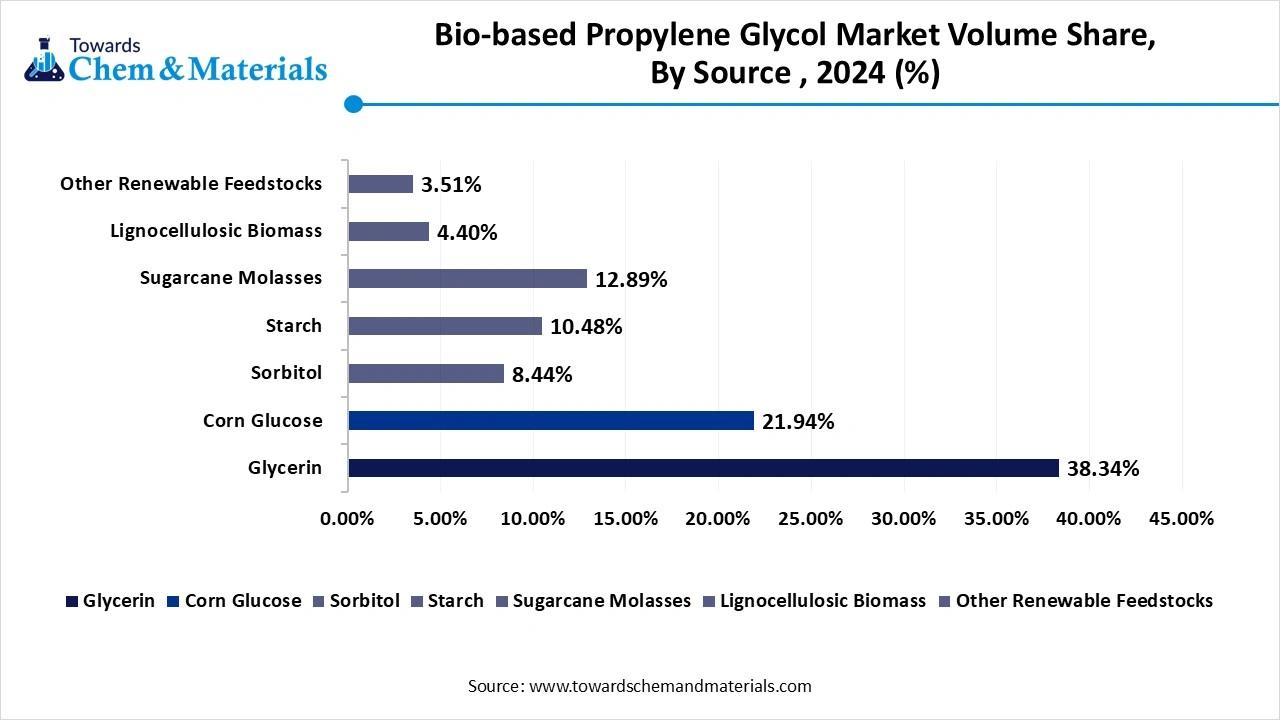
The corn glucose segment expects significant growth in the market during the forecast period. The biobased propylene glycol is produced from corn glucose through a process of fermentation and chemical conversion. In this, the corn glucose is fermented by using the microorganisms, which is then subjected to chemical reaction and then purified through distillation and other separation techniques. Propylene glycol is extensively used due to its benefits, offered as reduced carbon footprint, renewable feedstock, and meeting the standards for 100% bio-based renewable carbon content.
Global Bio-based Propylene Glycol Market Volume Share, By Source Volume, 2024-2034 (%)
| By Source Volume (Tons) | Volume Share, 2024 (%) | Volume (Tons)(2024) | Volume Share, 2034 (%) | Volume (Tons)(2034) | CAGR |
| Glycerin | 38.34% | 890,323.1 | 37.22% | 2,068,766.8 | 8.79% |
| Corn Glucose | 21.94% | 509,399.7 | 21.31% | 1,184,455.2 | 8.80% |
| Sorbitol | 8.44% | 195,874.3 | 8.83% | 490,790.2 | 9.62% |
| Starch | 10.48% | 243,447.9 | 11.12% | 618,073.3 | 9.76% |
| Sugarcane Molasses | 12.89% | 299,358.4 | 12.13% | 674,211.2 | 8.46% |
| Lignocellulosic Biomass | 4.40% | 102,139.3 | 5.01% | 278,466.5 | 10.55% |
| Other Renewable Feedstocks | 3.51% | 81,614.5 | 4.38% | 243,449.7 | 11.55% |
How Did Unsaturated Polyester Resins Segment Dominate the Bio-Based Propylene Glycol Market In 2024?
The unsaturated polyester resins (UPR) segment dominated the bio-based propylene glycol market in 2024. The growth of the market is driven by the growing demand for sustainable alternatives. They are extensively used in construction in products like paints, coatings, and electric elements, which increases the demand for the market. The versatile applications like composite materials, coating and adhesives, chemical anchoring, putties, fillers, and stucco also increase the demand for the market, supporting the growth and expansion of the market.
The personal care & cosmetics segment expects significant growth in the during the forecast period. The growth of the market is driven by the increasing demand for bio-based products due as changing preferences of the consumers for natural and eco-friendly products increase the adoption of biobased propylene glycol in the sector. It is used as a humectant, solvent, moisturizer, ingredient stabilizer, and as a preservative in cosmetics and personal care products, which increases the growth of the market.
Grade Insights
Which Grade Segment Dominated the Bio-Based Propylene Glycol Market In 2024?
The industrial grade segment dominated the bio-based propylene glycol market in 2024. The industry uses bio-based propylene glycol as it offers a sustainable and versatile solution for various industrial applications due to its eco-friendly nature and sustainable approach, which attracts consumers in diverse sectors. The benefits offered, like environmental regulations, sustainability, and reduced carbon footprint, also align with regulations. Industries like automotive, construction, and cosmetics demand the product due to its versatile properties and applications offered, which contribute to the growth and expansion of the market.
The food grade segment expects significant growth in the market during the forecast period. The growing demand for plant-based sources and ingredients increases the demand for the biobased product, which is used as a humectant, solvent, and stabilizer in various food products due to its safety, versatility, and sustainability, which boosts the growth of the market. They are commonly used and found in items like cold drinks, soft drinks, cake mixes, and even as food colorants. This drives the growth of the market and supports its expansion of the market.
How Did Hydrogenolysis of Glycerol Segment Dominate the Bio-Based Propylene Glycol Market In 2024?
The hydrogenolysis of glycerol segment dominated the bio-based propylene glycol market in 2024. Hydrogenolysis of glycerol is a key production process in the biobased propylene glycol market, utilizing renewable glycerol often derived as a byproduct from biodiesel production, to produce eco-friendly propylene glycol. This process involves breaking down glycerol under hydrogen pressure in the presence of catalysts, yielding high-purity propylene glycol with reduced environmental impact. The rising demand for sustainable, low-carbon chemicals and increasing glycerol availability drive the adoption of this process, supporting market growth and promoting greener industrial practices.
The fermentation of glucose segment is expected to experience significant growth in the market during the forecast period.
Fermentation of glucose is an important production process in the biobased propylene glycol market, leveraging renewable plant-based feedstocks like corn or sugarcane. In this method, glucose undergoes microbial fermentation to produce propylene glycol in an environmentally friendly and sustainable way. The growing demand for green chemicals in food, cosmetics, and pharmaceutical applications drives the adoption of glucose fermentation, supporting market expansion and advancing circular bioeconomy initiatives.
Which End-Use Segment Dominated the Bio-Based Propylene Glycol Market In 2024?
The automotive segment dominated the bio-based propylene glycol market in 2024. The growing use in the automotive industry is due to sustainable alternatives to the traditional petroleum-based propylene glycol, offering environmental benefits and aligning with the growing demand for green solutions in the automotive sector. It is extensively used as antifreeze and coolant in the automotive industry as it lowers the freezing point and prevents the engine from damage, which fuels the demand for the product. The government regulations and standards also help in meeting the need and demand for the product, boosting the growth and expansion of the market.
The pharmaceutical segment expects significant growth in the market during the forecast period. The growing and expanding pharmaceutical industry is increasingly using the biobased propylene glycol as it is a safe and sustainable alternative Along with this, the variety of applications and benefits, like use as solvent and stabilizer, growing demand, reduced environmental impact, consumer preference and government regulation supports the growth and expansion of the market.
How Did the Direct Sales Segment Dominate the Bio-Based Propylene Glycol Market In 2024?
The direct sales (B2B) segment dominated the bio-based propylene glycol market in 2024. Direct sales (B2B) is a key distribution channel in the biobased propylene glycol market, enabling manufacturers to supply large volumes directly to industrial end users such as chemical, pharmaceutical, cosmetic, and food processing companies. This approach offers benefits like tailored solutions, competitive pricing, and strong customer relationships. The increasing demand for sustainable, bio-based ingredients in various sectors drives the preference for direct B2B sales, supporting market growth, improving supply chain efficiency, and ensuring consistent product quality and availability.
The online platforms segment expects significant growth in the market during the forecast period. Online platforms are an emerging distribution channel in the biobased propylene glycol market, offering manufacturers and suppliers a flexible, accessible way to reach a broader range of customers. These platforms enable small and medium-sized businesses to easily procure bio-based propylene glycol in varying quantities, streamlining purchasing processes and reducing lead times. The convenience, transparency, and global reach of online sales channels support market growth, meet the rising demand for sustainable products, and enhance supply chain agility and responsiveness.
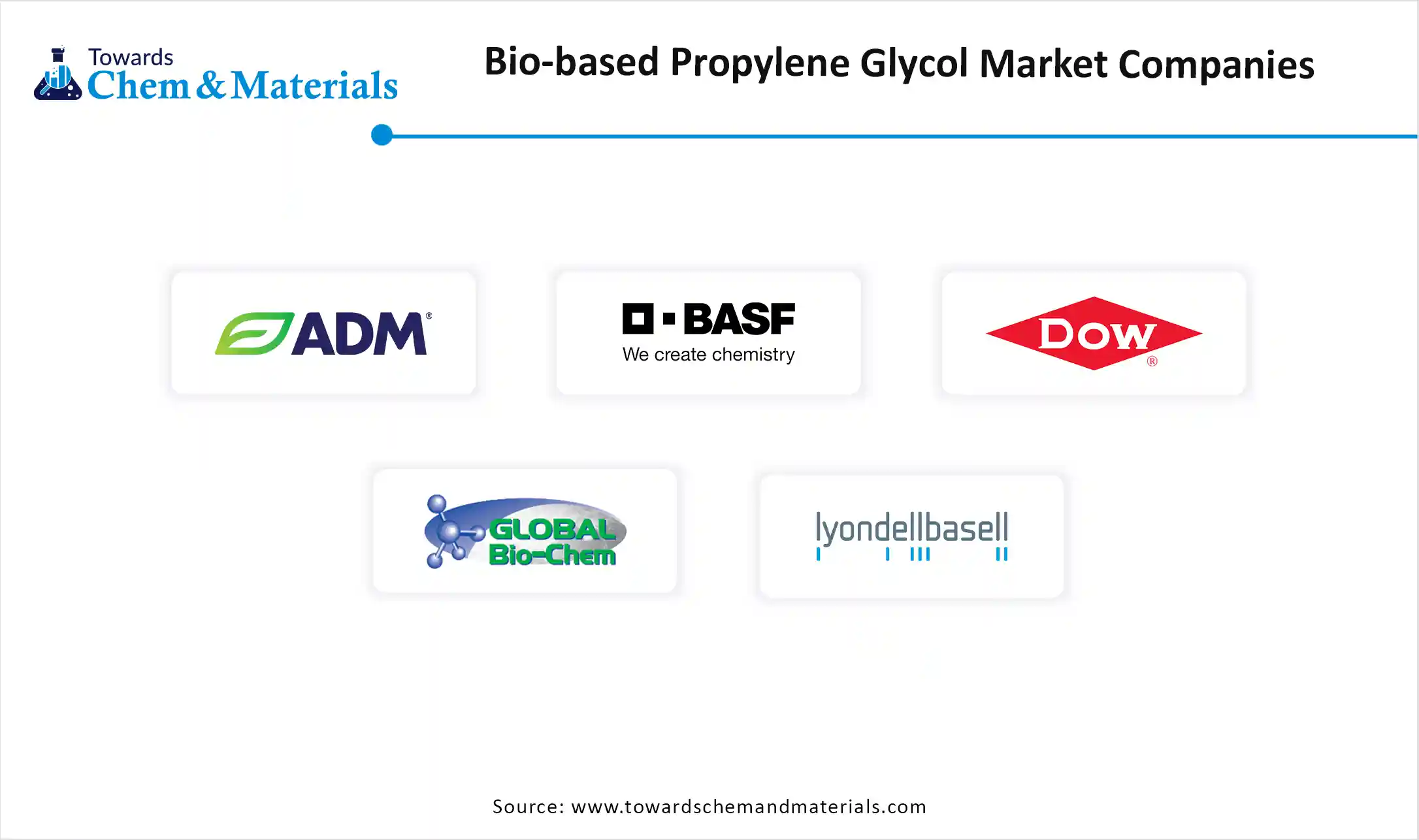
By Source (Feedstock Type)
By Application
By Grade
By Production Process
By End-use Industry
By Distribution Channel
By Region
October 2025
October 2025
October 2025
October 2025